Maharashtra Board Class 10 Science and Technology (N947) Question Paper 2023 with Solution PDF pdf is available for download here. The Science and technology paper was conducted on March 13, 2023 in the morning shift from 11:00 AM-2:00 PM. The question paper was divided into two sections - Section A for objective questions and Section B for subjective questions.
| Maharashtra Board Class 10 Science and Technology (N947) Question Paper With Solution PDF | Check Solution |

Write the correct alternative:
(i) Vestigial organ ................................... present in human body is proof of evolution.
View Solution
Step 1: Define vestigial organ
A vestigial organ is a reduced or rudimentary structure in a living organism that has lost most or all of its ancestral function through evolution. Vestigial structures provide evidence that species have changed over time because they are remnants of organs that were functional in ancestral species.
Step 2: Examine each option with respect to vestigial status
(A) Human hand: The human hand is fully functional for grasping, manipulation, and sensation; it is not reduced compared with ancestral function, so it is not vestigial.
(B) Appendix: The vermiform appendix in humans is a narrow, blind-ended tube attached to the cecum. In many herbivorous ancestors and relatives, a larger cecal pouch and associated structures aided cellulose digestion. In humans the appendix is much reduced in size and has no essential role in digestion for the typical adult, making it a classical example of a vestigial organ and evidence of evolutionary change.
(C) Ear muscles: Some auricular (ear) muscles are present in humans and are sometimes considered vestigial because they are reduced and most people cannot move their ears voluntarily; however, they are less commonly cited as the standard textbook proof of evolution compared with the appendix.
(D) Tail-bone: The coccyx (tail-bone) is also a vestigial structure, being the remnant of a tail present in ancestral primates; it is a valid example of vestigiality.
Step 3: Choose the best single answer
Both the appendix and the coccyx are vestigial structures, but among the given options the appendix is the classical, unambiguous textbook example frequently used as direct evidence of evolution. Therefore option (B) Appendix is the correct single-best choice.
Quick Tip: Vestigial organs are reduced remnants of formerly functional structures; common textbook examples in humans include the appendix and the coccyx, while fully functional structures like the hand are not vestigial.
Type of sexual reproduction is .................................... .
View Solution
Sexual reproduction is defined by the involvement of two specialized sex cells called gametes, one typically from each parent, which fuse during fertilization to form a zygote. The process that produces these haploid gametes is called gametogenesis, which includes spermatogenesis in males and oogenesis in females. Gametogenesis reduces the chromosome number by half through meiosis, ensuring genetic variation in offspring.
The other options describe asexual or regenerative processes: Fragmentation and budding are asexual methods where a single organism produces new individuals without gamete fusion; regeneration is the repair or regrowth of lost body parts and can be part of asexual reproduction in some organisms but does not involve formation and fusion of gametes. Therefore, among the given choices, gamete formation correctly represents sexual reproduction. Quick Tip: Remember: sexual reproduction requires meiosis and fusion of haploid gametes; look for terms like gametogenesis, meiosis, or fertilization.
The apex consumer is .................................... .
View Solution
An apex consumer, or apex predator, occupies the highest trophic level in a food chain and has no natural predators. Food chains typically progress from producers to primary consumers, then to secondary and tertiary consumers, with apex consumers at the top. In the given options the grasshopper is a primary consumer feeding on plants, the frog is a secondary consumer feeding on insects, the snake is a tertiary consumer feeding on frogs, and the eagle feeds on snakes and other animals but is not typically preyed upon, placing it at the apex. Therefore the eagle is the apex consumer. Quick Tip: Trace trophic levels from producer upward; the organism with no natural predators in the list is the apex consumer.
The Hydroelectric capacity of Koyna dam is .................................... .
View Solution
The Koyna Hydroelectric Project is a multi-stage hydroelectric complex on the Koyna River in Maharashtra. Its installed generation capacity, combining the turbines across the project stages and underground powerhouses, totals 1960 megawatts, making it one of India's largest completed hydroelectric power projects. The figure 1960 MW represents the aggregate installed capacity used for planning and reporting of the project. Quick Tip: When answering questions on major dams, recall the project's total installed capacity rather than single-unit ratings.
Animal with bilateral symmetry is .................................... .
View Solution
Bilateral symmetry means the body can be divided into two mirror-image halves along a single plane called the sagittal plane. Humans exhibit clear bilateral symmetry: the left and right sides of the body are mirror images in external form and arrangement of paired structures such as eyes, limbs, ears, and kidneys. This symmetry is associated with cephalization and directional movement in many animals.
Starfish display radial symmetry where body parts are arranged around a central axis and can be divided into similar halves by multiple planes through that axis; Paramoecium and Amoeba are unicellular organisms that show no true bilateral or radial symmetry and are effectively asymmetrical in shape and movement. Therefore, among the options given, human is the correct example of bilateral symmetry. Quick Tip: To identify bilateral symmetry, look for a single plane producing two mirror halves and paired structures on either side of the midline.
(i) State whether the following statement is true or false :
To take selfie on road is the invitation for accident
View Solution
Taking a selfie on the road diverts attention from surrounding traffic, pedestrians, and road hazards, which significantly increases the risk of collisions and accidents. Distracted posture or movement while focusing on a camera can lead to stepping into traffic, tripping, or sudden immobility that other road users cannot anticipate. Many road-safety guidelines classify using a mobile phone or camera on the roadway as a major behavioral hazard, and preventive measures include moving to a safe area off the road, remaining aware of traffic flow, and using hands-free arrangements only when stationary and safe. Therefore the statement is true. Quick Tip: Always move to a safe, designated area away from traffic before taking photos; never use phones while crossing or standing on the road.
Write the correct co-relation :
Insulin : diabetes :: Interferon : ..............
View Solution
Insulin is a hormone used to treat and regulate the disorder diabetes by lowering blood glucose and replacing or supplementing deficient insulin. Interferons are a group of signaling proteins produced by host cells that interfere with viral replication and modulate the immune response. Therapeutically, interferons are administered to treat certain viral infections, notably chronic hepatitis B and hepatitis C, and they are also used in some immune-related conditions and cancers. Therefore, the correct analogy pairs a therapeutic agent with the condition it treats:
\[ insulin : diabetes :: interferon : viral infections (example: hepatitis). \]
To elaborate on the therapeutic roles of these agents:
- Insulin and Diabetes: Insulin is a crucial hormone produced by the pancreas that helps regulate blood sugar levels by allowing glucose to enter cells for energy. In individuals with diabetes, particularly Type 1 diabetes, the body is unable to produce sufficient insulin, leading to high blood glucose levels. Insulin therapy is used to replace or supplement the deficient insulin, thus helping to lower blood glucose levels and maintain them within a normal range. In Type 2 diabetes, insulin may also be required if the body's ability to produce or respond to insulin becomes impaired. Proper insulin therapy can prevent complications such as diabetic ketoacidosis, cardiovascular disease, and nerve damage.
- Interferons and Viral Infections: Interferons are naturally occurring proteins that are part of the body’s immune response to viral infections. When a cell is infected by a virus, it releases interferons to signal neighboring cells to increase their antiviral defenses. Interferons also modulate the immune system by enhancing the activity of immune cells such as T cells and macrophages. Therapeutically, interferons are used to treat various viral infections, including chronic hepatitis B and hepatitis C, by stimulating the immune system to fight the virus more effectively. In addition, interferons have been used in the treatment of certain cancers and autoimmune diseases, as they help regulate immune responses.
In summary, the correct analogy reflects the therapeutic relationship between each agent and the condition it treats: insulin is used to manage diabetes, while interferon is used to treat viral infections like hepatitis. Both agents are examples of how specific therapies are designed to target and address particular medical conditions. Quick Tip: For analogies linking medicines to diseases, match the drug's primary therapeutic use (e.g., insulin → diabetes; interferon → viral hepatitis or other viral infections).
To which class does bat belong ?
View Solution
Bats are warm-blooded vertebrates that give birth to live young and feed their offspring with milk produced by mammary glands; they possess hair on their bodies and a four-chambered heart. These characteristics place bats in the class Mammalia. Bats also show other mammalian features such as presence of a neocortex in the brain and heterodont dentition; their ability to fly is a special adaptation within Mammalia but does not change their class-level placement. Therefore, the correct class is Mammalia.
Bats belong to the order \textit{Chiroptera, which is a group of mammals known for their ability to fly. Despite this unique ability, they are classified as mammals due to the following key characteristics:
- Warm-blooded (Endothermic): Bats, like all mammals, are warm-blooded, meaning they can regulate their body temperature internally. This allows them to remain active in varying environmental conditions, a feature that is essential for their survival in diverse habitats ranging from tropical rainforests to temperate regions.
- Live Birth and Lactation: Female bats give birth to live young, a definitive characteristic of mammals. After birth, they nurse their offspring with milk produced by specialized mammary glands, which is another hallmark trait of mammals. This reproductive strategy is shared by all members of the class Mammalia.
- Hair and Fur: Bats have hair on their bodies, which is a key feature of mammals. This fur helps to maintain body temperature, particularly in species living in colder climates or those that hibernate. The presence of hair, in addition to the other characteristics, clearly places bats within Mammalia.
- Four-chambered Heart: Like all mammals, bats have a four-chambered heart, which ensures efficient circulation of oxygenated blood throughout the body. This is important for sustaining their high metabolic rate, which is required for flight.
- Neocortex and Heterodont Dentition: Bats possess a neocortex in the brain, which is involved in higher-order functions such as sensory perception, motor control, and decision-making. They also have heterodont dentition, meaning their teeth are differentiated into various types (incisors, canines, molars) for different functions, such as biting, chewing, and grinding food.
- Adaptation for Flight: While flight is not a common trait among mammals, it is an adaptation that bats have evolved to exploit ecological niches. Bats' wings are modified forelimbs, and they are the only mammals capable of sustained flight. This ability is an evolutionary adaptation to help them capture prey (mainly insects) and navigate through the night. However, this adaptation does not change their classification as mammals.
In conclusion, while bats have evolved unique features like the ability to fly, their overall physiological traits and reproductive strategies clearly place them in the class Mammalia. Their membership in this class is supported by characteristics such as hair, live birth, lactation, a four-chambered heart, and advanced brain functions. Quick Tip: Identify class by key traits: hair or fur, mammary glands, live birth, and warm-bloodedness indicate Mammalia.
Match the correct pair :
Column ’A’ Column ’B’
(1) Forest Conservation Act (a) 1986
(b) 1980
(c) 1970
View Solution
The Forest (Conservation) Act was enacted by the Parliament of India and came into force on 25 October 1980, making 1980 the correct year to match with the Forest Conservation Act. The other years listed are not the year of enactment for this legislation.
The Forest (Conservation) Act of 1980 was a landmark piece of legislation aimed at preventing the diversion of forest land for non-forest purposes without prior approval from the central government. Key aspects of the Act include:
- Purpose of the Act: The primary aim of the Forest (Conservation) Act was to conserve India's forests and to regulate deforestation, particularly for purposes like agriculture, mining, and industrial projects. It sought to safeguard ecological balance and biodiversity by placing legal restrictions on the diversion of forest land for non-forest activities.
- Central Government Approval: The Act mandates that no forest land can be diverted to non-forest uses unless permission is granted by the central government. This ensures that any loss of forest cover is justified by essential public projects, while taking into account the long-term environmental impact.
- Environmental Impact: The Act was designed to address growing concerns over deforestation, environmental degradation, and the loss of biodiversity in India. It established a legal framework for balancing developmental needs with the need to protect and preserve forests.
- Amendments and Challenges: Over the years, the Forest (Conservation) Act has undergone amendments to address changing environmental, economic, and political conditions. Despite its successes in curbing deforestation, challenges remain, such as illegal logging, encroachments, and conflicts between development projects and forest conservation.
In conclusion, the Forest (Conservation) Act of 1980 was enacted with the goal of preserving India's forests and regulating land use. The Act continues to play a critical role in the country’s environmental protection efforts and in shaping policy decisions related to land and forest resources. Quick Tip: For matching legal acts with years, recall the year of enactment or commencement; landmark environmental laws in India include the Wildlife Protection Act 1972 and the Forest (Conservation) Act 1980.
Write the name of indicated part in diagram :
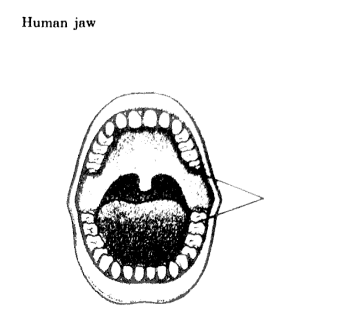
View Solution
The indicator points to the posterior inferior corner of the lower jaw, which is the angle formed where the lower border of the body of the mandible meets the posterior border of the ramus. This landmark is called the angle of the mandible. It serves as an attachment site for muscles such as the masseter and the medial pterygoid and is an important external landmark in clinical examination and maxillofacial anatomy.
The angle of the mandible is a crucial anatomical feature in the lower jaw, and it has several clinical and functional implications:
- Anatomical Location: The angle of the mandible is located at the junction where the body of the mandible (the horizontal portion) meets the ramus (the vertical portion). This corner-like structure is palpable just below the ear and is easily felt during a physical examination, making it an important reference point for both practitioners and students of anatomy.
- Muscle Attachments: Several muscles responsible for mastication (chewing) are attached to the mandible at or near the angle. Two important muscles, the masseter and the medial pterygoid, play a significant role in elevating the mandible during chewing. The masseter is a powerful muscle that is primarily responsible for closing the jaw, while the medial pterygoid assists in the grinding and chewing movements of the teeth. These muscle attachments at the angle of the mandible help facilitate efficient mastication.
- Clinical Relevance: The angle of the mandible is used as an external landmark in various clinical examinations, including the assessment of jaw function, facial symmetry, and the presence of temporomandibular joint (TMJ) disorders. It is also an important reference point in the planning of dental surgeries, orthodontics, and facial reconstructive procedures. For example, the angle of the mandible is often evaluated when assessing the alignment of the teeth or the development of the jaw.
- Maxillofacial Anatomy: In the field of maxillofacial surgery and anatomy, understanding the location and significance of the angle of the mandible is essential. Its relationship to the surrounding structures, such as the temporomandibular joint (TMJ), muscles of mastication, and neurovascular pathways, is crucial for diagnosing and treating various conditions, including fractures, TMJ dysfunction, and muscle disorders.
In summary, the angle of the mandible is a prominent anatomical landmark that plays a key role in mastication, clinical examination, and maxillofacial anatomy. Its significance in muscle attachment and as a reference point for surgery makes it essential for both diagnostic and therapeutic purposes in clinical practice. Quick Tip: Remember: the angle of mandible is at the junction of the mandibular body and ramus and is palpable below the earlobe when the mouth is closed.
(i) Sometimes higher plants and animals too perform anaerobic respiration.
View Solution
Anaerobic respiration occurs in higher plants and animals when oxygen supply to cells is insufficient for aerobic respiration, or when ATP demand temporarily exceeds the rate at which oxygen can be delivered. In animal muscle cells during intense exercise, oxygen delivery to muscle fibres becomes limiting, so pyruvate from glycolysis is reduced to lactic acid to regenerate NAD+, allowing glycolysis to continue and produce a small amount of ATP rapidly; this process is called lactic acid fermentation. In higher plants, waterlogged or compacted soils restrict O2 availability to roots, so some plant tissues switch to anaerobic pathways where pyruvate is converted to ethanol and carbon dioxide (alcoholic fermentation) to regenerate NAD+ and sustain ATP production at low yield.
Physiological consequences and adaptive value: anaerobic respiration yields much less ATP per glucose molecule than aerobic respiration, causes accumulation of by-products (lactic acid in animals, ethanol in plants) that can be toxic if persistent, and must be followed by recovery (oxygen repayment and removal or metabolism of by-products). Despite its low efficiency, anaerobic respiration provides a rapid short-term ATP supply that enables survival and continued function under hypoxic conditions or during bursts of high energy demand. Quick Tip: Key signs of anaerobic respiration: rapid ATP production under low O2, regeneration of NAD+ via fermentation, and accumulation of lactic acid (animals) or ethanol (plants).
(ii) It is absolutely necessary to control the fission reaction in nuclear power plant.
View Solution
A nuclear fission chain reaction releases a large amount of energy and produces more neutrons that can induce further fissions; without control the reaction can escalate rapidly, causing an uncontrollable rise in power and temperature. Controlling the reaction maintains a steady rate of fission so the heat produced matches the designed heat removal capacity of the reactor, preventing overheating and potential fuel damage or core meltdown. Controlled fission also limits the production and release of radioactive fission products by ensuring intact containment and proper cooling, thereby reducing radiation hazards to workers, the public, and the environment. Reactor control systems (control rods, neutron moderators, coolant flow regulation, and automatic shutdown systems) allow operators to adjust reactivity, respond to anomalies, and safely shut down the reactor if required. Reliable control is therefore essential for safe power generation, efficient fuel use, and minimization of radioactive releases. Quick Tip: Think safety first: control rods absorb excess neutrons, coolant removes heat, and automatic shutdown systems prevent runaway reactions.
(iii) Flower is structural unit of sexual reproduction in plant
View Solution
A flower is the reproductive structure of angiosperms that houses the organs required for sexual reproduction. The stamens (androecium) produce male gametes within pollen grains formed by microsporogenesis, and the carpels/pistils (gynoecium) contain ovules where female gametes (egg cells) form by megasporogenesis. Pollination transfers pollen to the stigma, followed by pollen germination and growth of the pollen tube through the style to deliver sperm cells to the ovule. Double fertilization occurs when one sperm fuses with the egg cell to form a zygote and the other fuses with the polar nuclei to form endosperm, ensuring embryo nourishment. Flowers also possess structural adaptations (petals, nectar, scent, floral symmetry) and mechanisms (self-compatibility, cross-pollination agents) that promote effective gamete transfer and genetic recombination. Because flowers contain the organs that produce gametes, enable their transfer, and permit fertilization and seed formation, a flower is correctly described as the structural unit of sexual reproduction in flowering plants. Quick Tip: Remember: stamens = male (pollen), carpels = female (ovules); pollination + pollen tube growth + fertilization = sexual reproduction in flowers.
(i) Write a short note on Environmental Conservation.
View Solution
Environmental conservation is the practice of protecting, managing, and restoring natural resources and ecosystems to ensure their sustainability for present and future generations. It encompasses actions to preserve biodiversity, maintain ecosystem services (such as clean air, water filtration, soil fertility, and climate regulation), and prevent degradation from pollution, deforestation, overexploitation, and habitat fragmentation. Key strategies include conservation of habitats (protected areas, restoration ecology), sustainable use of resources (sustainable agriculture, fisheries, and forestry), pollution control (waste reduction, emission standards), and conservation of water and energy through efficiency and renewables. Community engagement, environmental education, and policy measures (environmental legislation, incentives, and international agreements) are essential to align economic development with ecological limits. Conservation also requires scientific monitoring and adaptive management to respond to changing conditions, mitigate climate change impacts, and promote resilient landscapes that support both human well-being and biodiversity. Quick Tip: Think of conservation as three linked goals: protect species and habitats, use resources sustainably, and reduce pollution and waste.
Distinguish between Chordates and Non-chordates.
View Solution
Chordates and non-chordates can be distinguished by the presence or absence of key structural features at some stage of development. Major distinguishing characters are listed below.
\begin{tabular{ll
Feature & Chordates ; Non-chordates
Notochord & Present at some stage ; Absent
Dorsal hollow nerve cord & Present ; Usually ventral solid nerve cord or diffuse nerve net
Pharyngeal gill slits & Present at some stage ; Absent or modified differently
Post-anal tail & Present at some stage ; Absent or not persistent
Segmental arrangement & Myotomes and segmented muscles usually present ; Segmentation variable or absent
Endoskeleton & Often present (cartilage or bone) ; Usually absent or present as exoskeleton
Circulatory system & Closed in many chordates ; Usually open or more variable in non-chordates
Cephalization and advanced organ systems & Well developed (brain, sensory organs) ; Less specialized in many non-chordates
\end{tabular
Summary statement: Chordates are defined by the notochord, dorsal hollow nerve cord, pharyngeal slits, and post-anal tail appearing at some stage of life, whereas non-chordates lack this specific combination of features and show greater diversity in body plans and organ-system organization. Quick Tip: Remember the four hallmark chordate features: notochord, dorsal hollow nerve cord, pharyngeal slits, and post-anal tail.
Write the correct answer in blank circles :
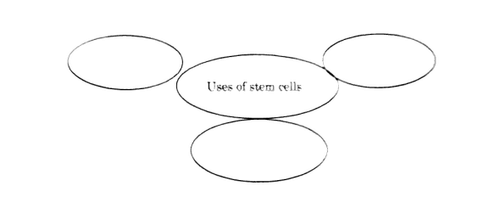
View Solution
Stem cells can self-renew and differentiate into specialised cell types, which enables several key applications. Regenerative therapy uses stem cells to replace or repair damaged tissues in conditions such as myocardial infarction, spinal cord injury, and neurodegenerative diseases. Haematopoietic stem cell transplants treat blood disorders like leukemia, thalassemia, and severe aplastic anemia by replenishing healthy blood and immune cells. Tissue and organ engineering employs stem cells with scaffolds and growth factors to grow tissues or organoids for transplantation or modelling. Drug testing and research use stem-cell-derived specialised cells to evaluate drug safety and efficacy and to model human diseases in vitro, reducing reliance on animal models. Quick Tip: When filling diagrams, pick the most distinct, high-impact applications: therapy, blood disorders, engineering, and research/testing.
Write down any two objectives of disaster management.
View Solution
1. Minimise loss of life and injury. Rapid preparedness, early warning systems, effective evacuation, timely medical response and search-and-rescue operations are implemented to protect human life and reduce casualties.
2. Reduce damage to property, infrastructure and environment. Risk assessment, mitigation measures (land-use planning, resilient construction), emergency resource management and post-disaster recovery planning limit economic losses and environmental degradation. Quick Tip: Effective disaster management links preparedness, mitigation, response and recovery to protect people, assets and ecosystems.
What are the benefits of mixing ethanol with petrol and diesel?
View Solution
Mixing ethanol with petrol reduces carbon dioxide and other pollutant emissions from vehicles, leading to cleaner air and lower contribution to greenhouse warming. Ethanol acts as an oxygenate and improves combustion quality, which can lower particulate and carbon-monoxide emissions and help keep fuel systems and injectors cleaner over long-term use. Blending ethanol increases the overall renewable-fuel fraction of the transport fuel mix, reducing dependence on crude oil and improving energy security while supporting agricultural value chains in rural areas that supply ethanol feedstock. Ethanol also has a higher octane rating than petrol, which can raise the blended fuel's octane number and reduce engine knocking, potentially allowing improved engine efficiency in compatible engines. Quick Tip: Ethanol blends (E10, E20, etc.) give environmental and energy-security benefits but must match vehicle compatibility and fuel-system materials for best performance.
3. (i) Darwin's theory of natural selection
View Solution
Statement: Natural selection is the process by which organisms better adapted to their environment tend to survive and produce more offspring; over generations this leads to evolution of populations.
\medskip
Key points:
Variation: Individuals in a population show heritable variation in traits.
Overproduction: Organisms produce more offspring than can survive, creating competition for limited resources.
Struggle for existence: Limited resources result in a struggle in which not all individuals survive to reproduce.
Differential survival and reproduction: Individuals with favourable heritable traits have higher survival or reproductive success.
Inheritance: Advantageous traits are passed to offspring, changing the frequency of alleles in the population.
Cumulative change: Small, accumulated changes across generations can produce adaptation and, over long periods, speciation.
\medskip
Mechanism:
Natural selection acts on phenotypic variation already present in a population; environmental pressures (predators, climate, resources, disease) favour individuals with traits that confer higher fitness; these individuals contribute proportionally more genes to the next generation, shifting population characteristics.
\medskip
Types of selection:
Stabilizing selection: Favors intermediate phenotypes, reducing variation.
Directional selection: Favors one extreme phenotype, shifting the population mean.
Disruptive selection: Favors both extremes, which can promote divergence and speciation.
\medskip
Evidence supporting the theory:
Fossil record: Transitional forms and sequences of change over time.
Comparative anatomy: Homologous structures implying common ancestry.
Embryology: Similar early developmental stages among related groups.
Biogeography: Geographic distribution patterns consistent with divergence and adaptation.
Direct observation: Examples such as antibiotic resistance and industrial melanism.
Molecular biology: DNA and protein similarities that reflect evolutionary relationships.
\medskip
Limitations and modern extension:
Darwin did not know the genetic mechanism of inheritance; the modern synthesis integrated Mendelian genetics and population genetics with natural selection, explaining how variation is produced and transmitted and how allele frequencies change. Quick Tip: Remember the logical sequence: variation → competition → differential survival → inheritance → cumulative change.
3. (ii) Complete the following chart :
Sr. No. Proteins Name of the Organs
1. Melanin, Keratin ______________
2. Insulin, Trypsin ______________
3. Haemoglobin, Antibodies ______________
View Solution
1. Melanin, Keratin — Skin. Melanin is the pigment produced by melanocytes in the epidermis that determines skin colour and protects against UV radiation; keratin is a fibrous structural protein of epidermal cells, hair and nails that provides mechanical strength and waterproofing.
2. Insulin, Trypsin — Pancreas. Insulin is a peptide hormone secreted by the pancreatic islets (beta cells) that regulates blood glucose; trypsin is a proteolytic enzyme produced by the pancreas (secreted as trypsinogen) that helps digest proteins in the small intestine.
3. Haemoglobin, Antibodies — Blood. Haemoglobin is the oxygen-carrying protein in red blood cells; antibodies (immunoglobulins) are proteins produced by B lymphocytes circulating in blood and plasma that recognise and neutralise pathogens. Quick Tip: Match each protein to the organ or tissue where it is synthesised or primarily functions: pigments and structural proteins to skin, digestive enzymes and hormones to pancreas, and transport/immune proteins to blood.
3. (iii) Write the factors affecting environment
View Solution
1. Abiotic factors: Climate (temperature, rainfall), sunlight, water availability, soil type and minerals, air composition, topography and natural chemical conditions.
2. Biotic factors: Producers (plants), consumers (animals), decomposers (microbes), species interactions (predation, competition, symbiosis) and biodiversity levels.
3. Human activities: Deforestation, urbanisation, industrialisation, agriculture (use of fertilisers and pesticides), pollution (air, water, soil), overexploitation of resources and waste generation.
4. Natural events: Earthquakes, floods, droughts, volcanic eruptions, cyclones and fires that cause sudden or long-term environmental change.
5. Socioeconomic and technological factors: Population growth, consumption patterns, policies and laws, technology and infrastructure that influence resource use and environmental management. Quick Tip: Group factors as abiotic, biotic, anthropogenic and natural events to organise answers clearly.
1. Name the parts labelled A, B and C:
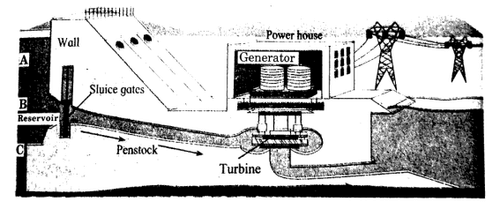
View Solution
A: Wall (dam)
A dam is a large structure built across a river or waterway to hold back or control the flow of water. The primary purpose of a dam is to store water for various uses such as irrigation, power generation, or flood control. Dams can be made of concrete, earth, or rock and are designed to withstand significant pressure from the water they contain. The construction of a dam often requires careful planning to ensure it does not disrupt the local ecosystem or lead to unintended consequences such as landslides or water shortages downstream.
[4pt]
B: Sluice gates
Sluice gates are structures built into dams or canals that allow the controlled release of water. These gates are typically adjustable, enabling operators to regulate the flow of water based on current needs or conditions, such as during floods or periods of drought. Sluice gates play an essential role in maintaining the stability of the dam and the surrounding environment by preventing the water from accumulating too much and causing structural damage. They are also used to direct water to irrigation systems, hydroelectric power plants, or other areas where the water is needed.
[4pt]
C: Penstock
A penstock is a large pipe or conduit that carries water from a reservoir or dam to a turbine in a hydroelectric power plant. The penstock is designed to direct the flow of water efficiently, utilizing gravity or pressure to generate kinetic energy that drives the turbine. The design and maintenance of a penstock are critical for the efficient generation of power, as any blockage or leak can reduce the effectiveness of the system. Penstocks are often made of steel or reinforced concrete to withstand the high pressure exerted by the water as it flows through the system. Quick Tip: A is the dam wall, which holds back the water and creates the reservoir. B is the sluice gates, which control water flow into the penstock. C is the penstock, which channels the water to the turbine for power generation. Each component works together to produce electricity efficiently!
2. Function of the sluice gates:
View Solution
Sluice gates regulate the flow of water from the reservoir into the penstock; they control water discharge for power generation and allow release of excess water for flood management.
Sluice gates are critical components in water management systems, particularly in dams and hydroelectric power plants. They are typically positioned at the base of a dam or along a water channel to control the flow of water. The primary functions of sluice gates include:
- Regulation of Water Flow: Sluice gates control the rate at which water is released from the reservoir into the penstock. By adjusting the position of the gates, operators can control the amount of water entering the turbine, thus managing the power generation process. This is crucial for maintaining a consistent and stable output of electricity.
- Flood Management: Sluice gates also serve an important role in flood control by releasing excess water during periods of heavy rainfall or snowmelt. By regulating the flow of water, sluice gates help prevent the dam from being overwhelmed, thereby reducing the risk of downstream flooding. Excess water can be safely directed through spillways or other drainage systems to manage flood risks.
- Maintenance of Structural Integrity: By allowing controlled water release, sluice gates also help maintain the structural integrity of the dam. They reduce the risk of pressure build-up behind the dam, which could otherwise lead to structural failure or erosion.
In summary, sluice gates are vital for balancing the needs of power generation, flood management, and dam safety. They ensure that water flow is managed efficiently and safely, supporting both the energy production process and environmental stability. Quick Tip: Sluice gates play a dual role—they control the flow of water into the penstock for power generation and can also release excess water to prevent flooding, helping to balance both energy production and safety.
3. Describe the path of water to generate electricity in the plant:
View Solution
N/A Quick Tip: In a hydroelectric system, the sluice gates release water from the reservoir into the penstock, creating high pressure. As the water flows through the penstock and spins the turbine, the mechanical energy from the turbine is then converted into electrical energy by the generator, powering homes and industries!
4. Role of the penstock and turbine:
View Solution
N/A Quick Tip: In a hydroelectric system, the penstock carries high-pressure water from the reservoir to the turbine, converting potential energy into kinetic energy. The turbine then spins, converting that kinetic energy into mechanical energy, which drives the generator to produce electricity. It’s a perfect example of energy transformation in action!
(a) With reference to point B
View Solution
When the sluice gate at point B is opened, the stored water above the gate (water at levels A and B in the reservoir) flows through the gate and its potential energy is converted into kinetic energy as it moves down the penstock towards the turbine. Quick Tip: When the sluice gate at point B opens, the water's potential energy (from being stored at higher levels) turns into kinetic energy as it flows down through the penstock to the turbine. This process is key in generating hydroelectric power, as the moving water drives the turbine to produce electricity!
(b) What will be the effect on electricity generation, if the channel taking water to turbine starts at point A?
View Solution
Point A is at a higher water level than point B, so water starting from A has greater gravitational potential energy. When this water flows through the penstock to the turbine, the larger head produces higher water pressure and greater kinetic energy at the turbine runner, causing the turbine to rotate with more torque and speed. As a result the generator delivers more electrical power, provided the turbine and generator are rated to utilise the increased flow and head and the system can safely handle the higher pressure. Quick Tip: Higher head (greater vertical drop) increases the available mechanical power for a hydro turbine, increasing electrical output if equipment limits are not exceeded.
(c) What will be the effect on electricity generation, if the channel taking water to turbine starts at point C?
View Solution
Point C is at a lower water level than points A and B, so the vertical head available to the turbine is reduced when water is taken from C. Reduced head means lower potential energy per unit mass of water, producing less kinetic energy at the turbine runner; the turbine therefore receives less torque and rotates more slowly, so the generator produces less electrical power. If the head and flow fall below the turbine's design limits, generation may become inefficient or stop altogether. Secondary effects include increased flow rate required for the same power, higher relative losses, and possible cavitation if operating conditions are unsuitable. Quick Tip: Power from a hydroturbine is roughly proportional to head and flow; lowering the intake level reduces head and therefore reduces power output.
From the following animals which can regenerate its broken body part?
View Solution
Star fish (phylum Echinodermata) possess remarkable regenerative ability; they can regenerate lost arms and, in some species, an entire individual can develop from a single severed arm if part of the central disc is attached. Regeneration involves cell proliferation and re-patterning to replace tissues and organs. Cockroaches and frogs show limited regeneration under specific conditions (cockroach limbs can regrow during successive molts; amphibian larvae regenerate tails), while birds such as sparrows lack significant regenerative capacity for major body parts. Quick Tip: Remember: echinoderms like starfish are classic examples of extensive regeneration in animals.
(vi) Complete the diagram showing various processes in tissue culture
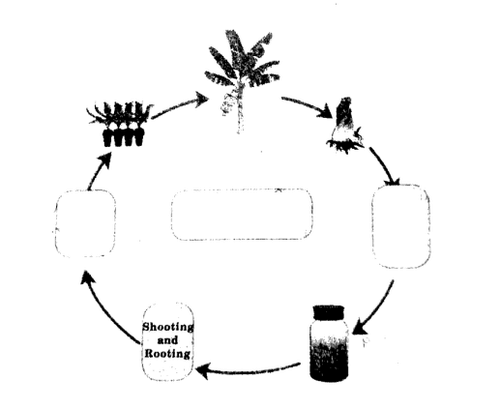
View Solution
1. Explant selection and excision: Choose a healthy part (meristem/shoot tip) from the mature plant and excise it aseptically.
2. Surface sterilization: Remove surface microbes from the explant using disinfectants so it can be handled in sterile conditions.
3. Inoculation on sterile culture medium: Place the sterilized explant on nutrient agar or liquid medium with growth regulators to induce callus formation and shoot initiation.
4. Shooting and Rooting: Promote shoot multiplication and root formation using appropriate hormones in vitro.
5. Hardening and acclimatization: Gradually adapt rooted plantlets to external conditions by transferring them to soil/greenhouse under controlled humidity and light.
6. Planting and maturation: Transplant hardened plantlets to the field or nursery where they grow into mature plants, completing the cycle. Quick Tip: Key stages to fill diagram blanks: Explant selection, Surface sterilization, Inoculation on medium, and Hardening/acclimatization before field planting.
(vii) Which fuels are obtained from biomass?
View Solution
Biomass yields different types of fuels depending on processing:
Solid biofuels: Firewood, charcoal, crop residues, dung cakes and wood pellets used directly for heating and cooking.
Liquid biofuels: Bioethanol produced by fermentation of sugars (e.g., from sugarcane, corn); biodiesel produced from vegetable oils or animal fats by transesterification; straight vegetable oils used in some engines.
Gaseous biofuels: Biogas (mainly methane and CO2) produced by anaerobic digestion of organic wastes; producer gas or syngas from gasification of biomass.
These biofuels are renewable and can reduce dependence on fossil fuels and lower net greenhouse gas emissions when produced sustainably. Quick Tip: Biomass can be processed into solid, liquid, or gaseous biofuels, offering renewable energy options that help reduce fossil fuel use. Whether it's firewood for heating, bioethanol from sugar crops, or biogas from organic waste, these biofuels can contribute to sustainability and lower greenhouse gas emissions when managed responsibly!
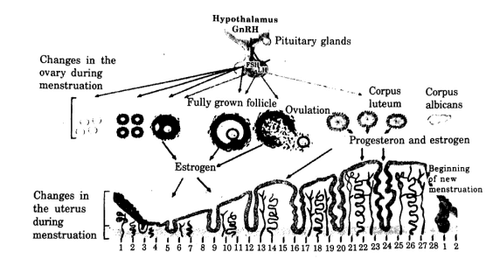
Question 32:
(a) What is the period of menstruation?
View Solution
Days 1 to 4 of the menstrual cycle.
On days 1 to 4, the menstrual bleeding occurs, also known as menstruation. This is the shedding of the uterine lining (endometrium) when fertilization has not occurred. During this phase:
- Day 1: The first day of menstrual bleeding marks the beginning of a new cycle. Hormone levels (estrogen and progesterone) are low, and the lining of the uterus begins to shed.
- Day 2: The bleeding continues, and the flow may be moderate to heavy. The body continues to expel the old endometrial lining.
- Day 3: The bleeding usually starts to taper off. The hormone levels remain low, but the body is preparing for the next phase of the cycle.
- Day 4: Light bleeding or spotting may occur. By the end of day 4, the bleeding typically slows significantly, signaling the end of menstruation. The body begins to prepare for the follicular phase, where an egg will mature in the ovaries.
This phase is often accompanied by mild cramps, headaches, and other symptoms as the body adjusts to hormone fluctuations. Quick Tip: During days 1 to 4 of your menstrual cycle, staying hydrated, using a heating pad for cramps, and eating nutrient-rich foods can help ease discomfort. Remember to listen to your body and rest if needed—this phase is all about recovery and preparation for the next stage of your cycle!
(b) On which day does ovulation occur during menstrual cycle?
View Solution
Around day 14 in a typical 28-day cycle.
Around day 14 of a typical 28-day menstrual cycle, ovulation occurs. This is the release of a mature egg (oocyte) from the dominant follicle in the ovary. During this time:
- Hormonal Changes: Luteinizing hormone (LH) and follicle-stimulating hormone (FSH) levels surge in response to rising estrogen levels. This hormonal spike triggers ovulation.
- Ovulation: The mature egg is released from the ovary and travels down the fallopian tube, where it may be fertilized by sperm. Ovulation typically occurs 12 to 24 hours after the LH surge.
- Cervical Mucus: The cervical mucus becomes thinner and more slippery, resembling egg whites, which facilitates sperm movement toward the egg.
- Body Temperature: Basal body temperature (BBT) rises slightly after ovulation due to increased progesterone production. This rise in temperature can help track ovulation if charting BBT.
Ovulation is the most fertile phase of the menstrual cycle, and this is when conception is most likely to occur if sperm is present. The body prepares for the potential of pregnancy, and the endometrial lining continues to thicken in anticipation of implantation. Quick Tip: Around day 14 of your cycle, you’re at your most fertile window! If you're trying to conceive, this is the time to be extra mindful of tracking ovulation signs like changes in cervical mucus and basal body temperature. For those avoiding pregnancy, consider using additional contraception during this time.
(c) In menstrual cycle which reproductive organs undergo changes?
View Solution
Ovary and uterus (endometrium).
The ovary and uterus play crucial roles in the menstrual cycle, fertility, and pregnancy. Here's an explanation of each structure and its function:
- Ovary: The ovaries are two small, almond-shaped organs located on either side of the uterus. Their primary function is to produce eggs (oocytes) and secrete hormones such as estrogen and progesterone.
- Follicular Phase: During the follicular phase of the cycle, which begins at menstruation and ends at ovulation, several follicles in the ovaries begin to mature. One of these follicles becomes dominant and prepares to release an egg during ovulation.
- Ovulation: At around day 14 of a typical 28-day cycle, a mature egg is released from the dominant follicle and enters the fallopian tube, ready for possible fertilization. The ovary also produces estrogen, which helps thicken the uterine lining in preparation for implantation.
- Luteal Phase: After ovulation, the ruptured follicle transforms into the corpus luteum, which produces progesterone. This hormone supports the endometrial lining for a potential pregnancy. If fertilization does not occur, the corpus luteum degenerates, leading to a drop in progesterone levels and the start of menstruation.
- Uterus (Endometrium): The uterus is a hollow, muscular organ where a fertilized egg implants and develops during pregnancy. The inner lining of the uterus, called the endometrium, undergoes cyclical changes in response to hormonal signals from the ovaries.
- Menstrual Phase: If pregnancy does not occur, the levels of estrogen and progesterone drop, leading to the shedding of the endometrial lining. This results in menstruation, or the period.
- Proliferative Phase: Following menstruation, the endometrium thickens under the influence of estrogen, preparing for potential embryo implantation.
- Secretory Phase: After ovulation, progesterone from the corpus luteum further thickens the endometrial lining, making it more receptive to an embryo. If fertilization occurs, the embryo implants in the endometrium. If not, the endometrial lining breaks down and is shed during the next menstrual cycle.
In summary, the ovaries and the uterus work together to regulate the menstrual cycle, facilitate fertilization, and support pregnancy when it occurs. Quick Tip: The ovary and uterus work closely during the menstrual cycle. The ovary releases eggs, while the uterus prepares its lining (endometrium) for a potential pregnancy. If no fertilization occurs, the endometrial lining sheds during menstruation, and the cycle starts again!
(d) Which period is said to be period of regeneration of endometrium?
View Solution
The proliferative phase (after menstruation, roughly days 5–13) when the endometrium is rebuilt.
The proliferative phase is the second phase of the menstrual cycle, occurring after menstruation, typically between days 5 and 13 of a 28-day cycle. During this phase, the endometrial lining (the inner layer of the uterus) is rebuilt and prepared for potential implantation of a fertilized egg. The main processes and hormonal changes during this phase include:
- Hormonal Changes: Estrogen levels rise as the developing follicles in the ovaries secrete this hormone. Estrogen stimulates the growth and regeneration of the endometrial lining, preparing it to support a fertilized egg.
- Endometrial Regeneration: After menstruation, when the endometrial lining has been shed, the lining starts to thicken and rebuild. The proliferation of the endometrial cells occurs, making the uterus more receptive to implantation. The glands and blood vessels in the endometrium begin to grow and become more complex.
- Follicular Development: During this phase, one dominant follicle in the ovary matures under the influence of FSH (follicle-stimulating hormone). This follicle produces increasing amounts of estrogen, which supports the growth of the endometrium.
- Cervical Mucus Changes: The cervical mucus becomes thinner, clearer, and more slippery, resembling raw egg whites. This facilitates sperm movement through the cervix into the uterus, creating an optimal environment for fertilization.
- Increased Blood Flow: The endometrial tissue receives increased blood flow, which prepares it to support an embryo in the event of pregnancy. This phase ends when ovulation occurs (around day 14), triggered by a surge in luteinizing hormone (LH) and FSH, signaling the release of the egg from the ovary.
The proliferative phase is essential for fertility, as the preparation of the endometrial lining is necessary for implantation. If ovulation occurs and the egg is fertilized, the endometrial lining will continue to support the embryo. If fertilization does not happen, the cycle continues into the secretory phase. Quick Tip: The proliferative phase (days 5-13) is when your body rebuilds the uterine lining after menstruation. Estrogen levels rise, stimulating the endometrium to thicken in preparation for a potential pregnancy. It’s a time of renewal, so you might feel more energized as your body gears up for ovulation!
(e) Which period is said to be period of secretions of glands in endometrium?
View Solution
During the secretory phase, the endometrial glands become highly coiled and secrete nutritive fluids under the influence of progesterone produced by the corpus luteum, preparing the lining for possible implantation.
The secretory phase follows ovulation and typically lasts from day 15 to day 28 in a 28-day cycle. This phase is characterized by significant hormonal and structural changes that make the endometrium receptive to a fertilized egg. Key aspects of the secretory phase include:
- Hormonal Changes: After ovulation, the ruptured follicle in the ovary transforms into the corpus luteum, which begins to secrete progesterone. Progesterone plays a critical role in maintaining the thickened endometrial lining, making it more suitable for embryo implantation. Estrogen levels also remain elevated, but progesterone takes the lead during this phase.
- Endometrial Changes: Under the influence of progesterone, the endometrial glands become more coiled and increase in size. The glands begin to secrete a thick, nutritious fluid, providing an ideal environment for a potential embryo. The stroma (the connective tissue in the endometrium) also becomes more edematous (fluid-filled) and more vascular, enhancing the uterine lining's ability to nourish a developing embryo.
- Cervical Mucus: During the secretory phase, cervical mucus becomes thicker and less receptive to sperm, which helps prevent fertilization during this time, as the body shifts focus to possible implantation and pregnancy.
- Implantation Window: The endometrial lining reaches its peak thickness and nutrient content around days 20–24 of the cycle. If fertilization has occurred, the embryo may implant into the lining during this "implantation window." The uterine lining secretes factors that promote successful implantation and early embryonic development.
- Corpus Luteum Function: If pregnancy does not occur, the corpus luteum degenerates, leading to a sharp drop in progesterone levels. This drop triggers the breakdown of the endometrial lining, marking the transition into the menstrual phase and the start of a new cycle. If fertilization and implantation occur, the corpus luteum is maintained by human chorionic gonadotropin (hCG), ensuring continued progesterone secretion to support the pregnancy.
In summary, the secretory phase is crucial for the preparation of the uterine lining to support implantation and early pregnancy. The hormonal and structural changes that take place during this phase are essential for a successful pregnancy to occur if fertilization happens. Quick Tip: During the menstrual cycle remember the sequence: menstrual phase (shedding) → proliferative phase (regeneration under estrogen) → ovulation (around day 14) → secretory phase (glandular secretion under progesterone); match ovarian events (follicle growth, ovulation, corpus luteum) with uterine changes for clear answers.
Solve the following crossword
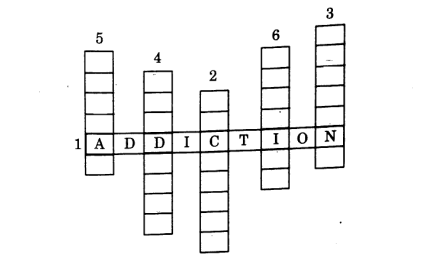
View Solution
1. Continuous consumption of alcoholic and tobacco materials — Addiction.
Addiction to substances such as alcohol and tobacco is a condition where an individual
becomes dependent on these substances. This dependence can lead to both physical and
psychological effects, often damaging health, relationships, and overall quality of life. Over
time, it can result in a variety of health problems such as liver disease, lung cancer, and
mental health issues. Addressing addiction typically requires a combination of therapy,
support groups, and sometimes medical intervention.
2. This app may cause cyber crimes — Facebook.
Social media platforms like Facebook have the potential to enable cybercrimes such as
identity theft, cyberbullying, and data breaches. Due to their widespread use, these platforms
can also be used by malicious individuals for illegal activities, including fraud and
harassment. It’s crucial for users to practice online safety, such as using strong passwords
and being cautious about sharing personal information, to minimize the risk of becoming
victims of cybercrimes.
3. A remedy to resolve stress — Singing.
Singing is an effective stress-relief activity that can help reduce tension and promote a sense
of well-being. It triggers the release of endorphins, the body’s natural feel-good hormones,
and has been shown to lower cortisol levels, which are associated with stress. Whether done
alone or in a group, singing can provide an emotional outlet, help improve mood, and even
strengthen the immune system.
4. Requirement for stress-free life — Good food.
Proper nutrition plays a vital role in supporting both physical and mental health, making it an
essential requirement for a stress-free life. A balanced diet rich in vitamins, minerals, and
antioxidants helps maintain energy levels, stabilize mood, and improve cognitive function.
Foods such as fruits, vegetables, whole grains, and lean proteins contribute to reducing the
negative impacts of stress and boosting overall mental clarity and well-being.
5. Various factors affect health — Social.
Social health refers to the quality of an individual’s relationships and interactions with
others. Various factors affect social health, including family dynamics, friendships,
community involvement, and cultural influences. Positive social connections contribute to a
sense of belonging, emotional support, and personal well-being, while social isolation or
unhealthy relationships can lead to stress, anxiety, and other mental health issues.
6. Art of preparing food items — Cooking.
Cooking is the practice of preparing food for consumption, and it involves various
techniques, skills, and knowledge about ingredients and culinary traditions. Cooking not
only serves as a creative outlet but also promotes healthier eating habits by allowing
individuals to control the ingredients and methods of preparation. It is an essential life skill
that can also be a source of enjoyment, relaxation, and cultural expression.
Quick Tip:Match each clue to a single-word or short-phrase answer that fits the theme of health,
habits and lifestyle.
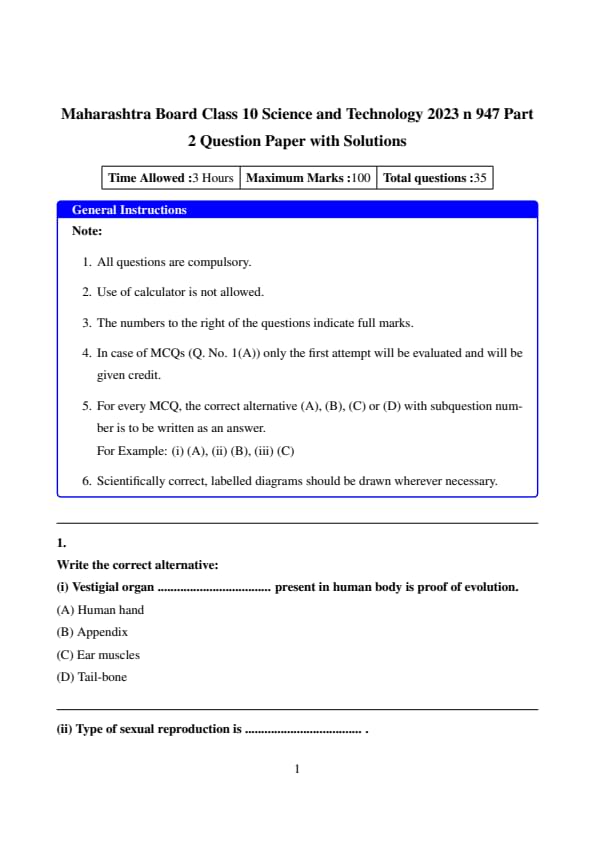
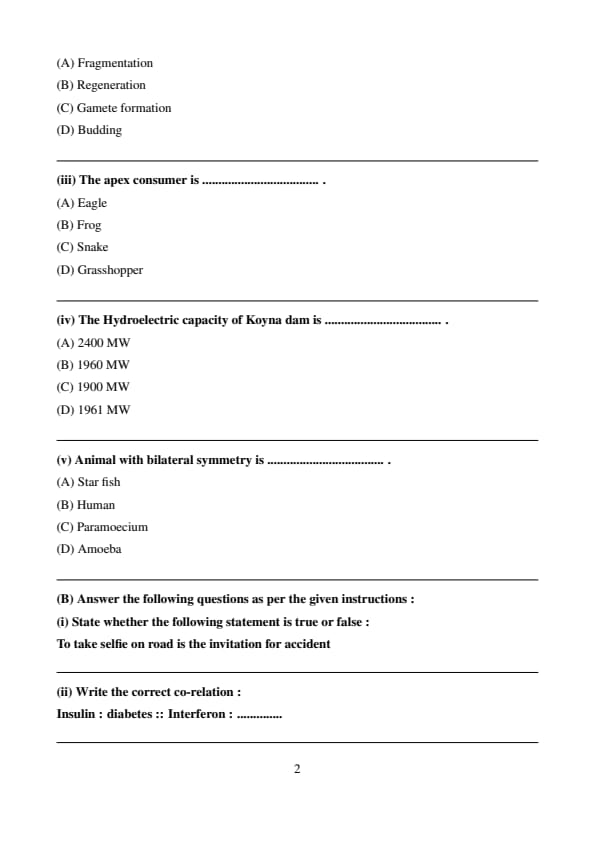
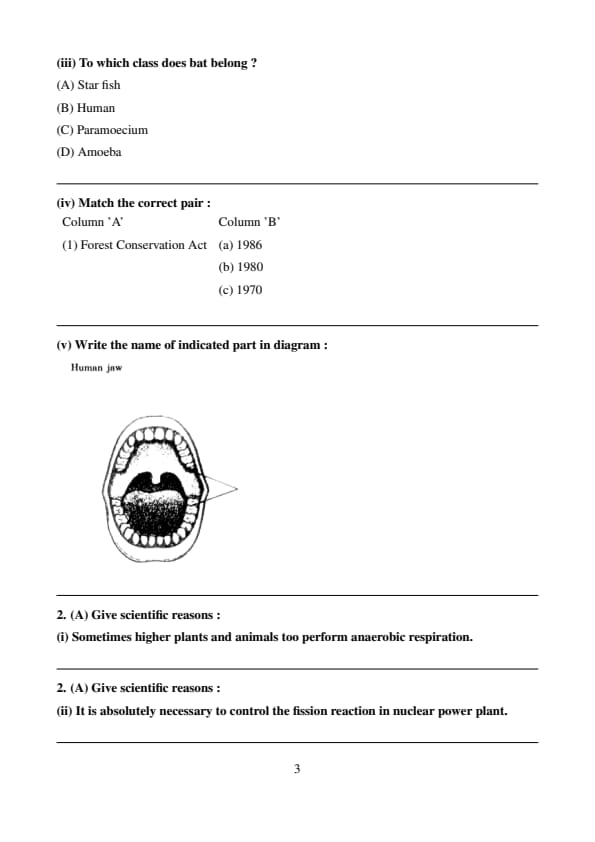
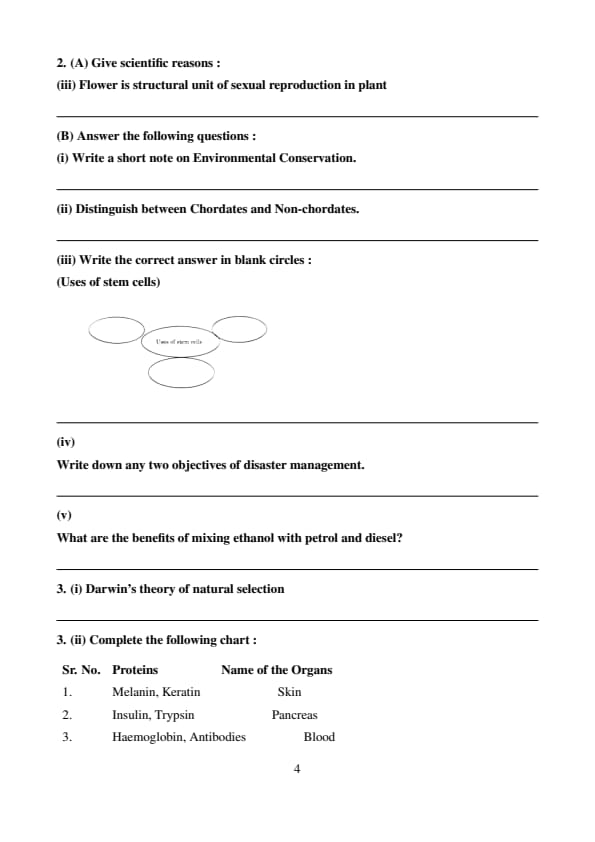
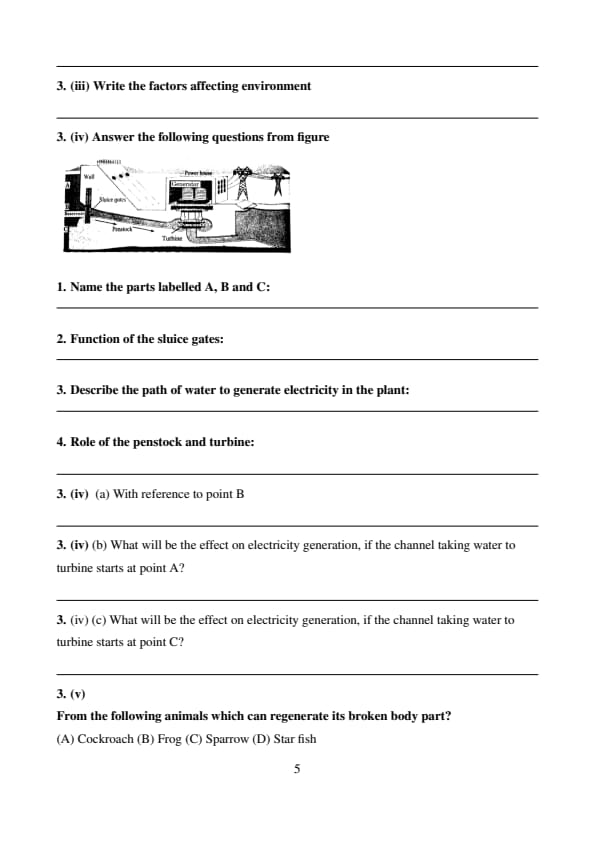
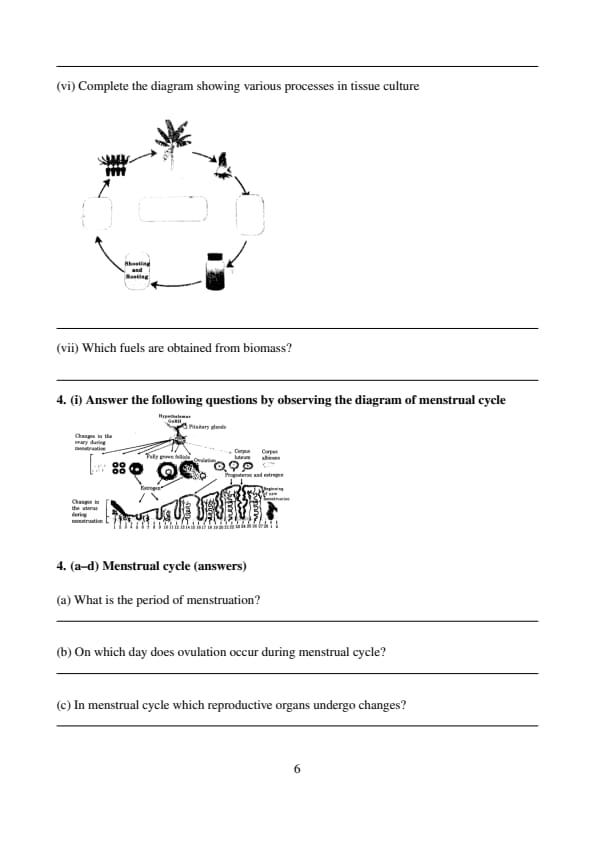
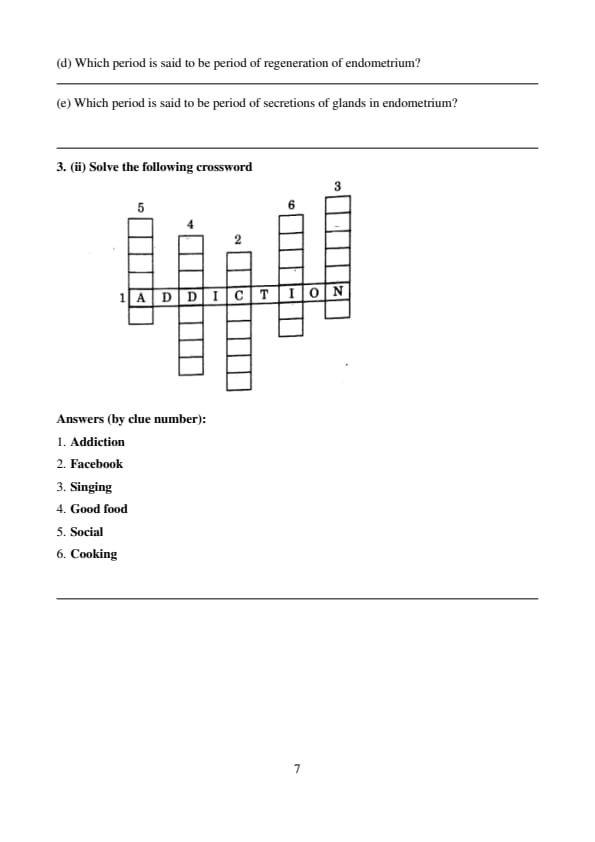



Comments